The winter months of December, January and February are all excellent times to visit Zion National Park to benefit from fewer crowds, cheaper hotel rooms and quieter trails. And that’s a big deal. Plus, you can even drive your own vehicle to trailheads in the main canyon. We spent three days hiking in Zion’s major regions back in December 2021 and it was a total contrast to our previous visit in October 2019.
In this guide we walk you through the 10 most important things to know about visiting Zion in winter, based on our experiences.
Our Experience
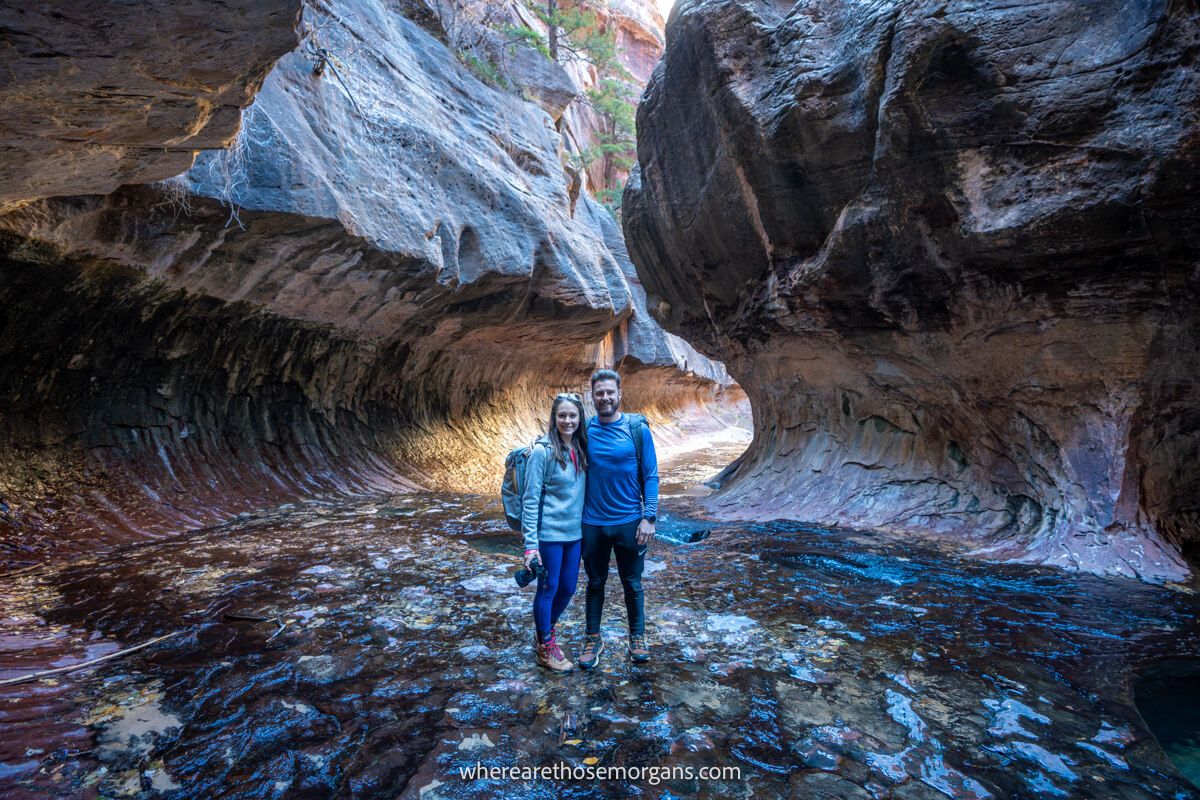
We were genuinely shocked at how busy Zion was when we visited in October 2019. Getting parked at trailheads or the visitor center to get the shuttle was out of control. Seriously, it was a mess. And that was October, not July or August. Hotels were expensive, restaurants were full and trails like Angels Landing were jam-packed. We still had a fantastic time, but we decided the next time we visited would be in the off season.
And what a different it made. We essentially had the freedom of the park at Zion in December. Hiking trails were empty (even Angels Landing), we had no issues getting a next day permit to hike The Subway, Zion Lodge had a ton of availability, hotels in Springdale were empty and restaurants in town were quiet. Sure, it was cold in the morning and at night. But we’d take brisk overnight temperatures for quiet trails any day! Read more about us.
1. Crowds
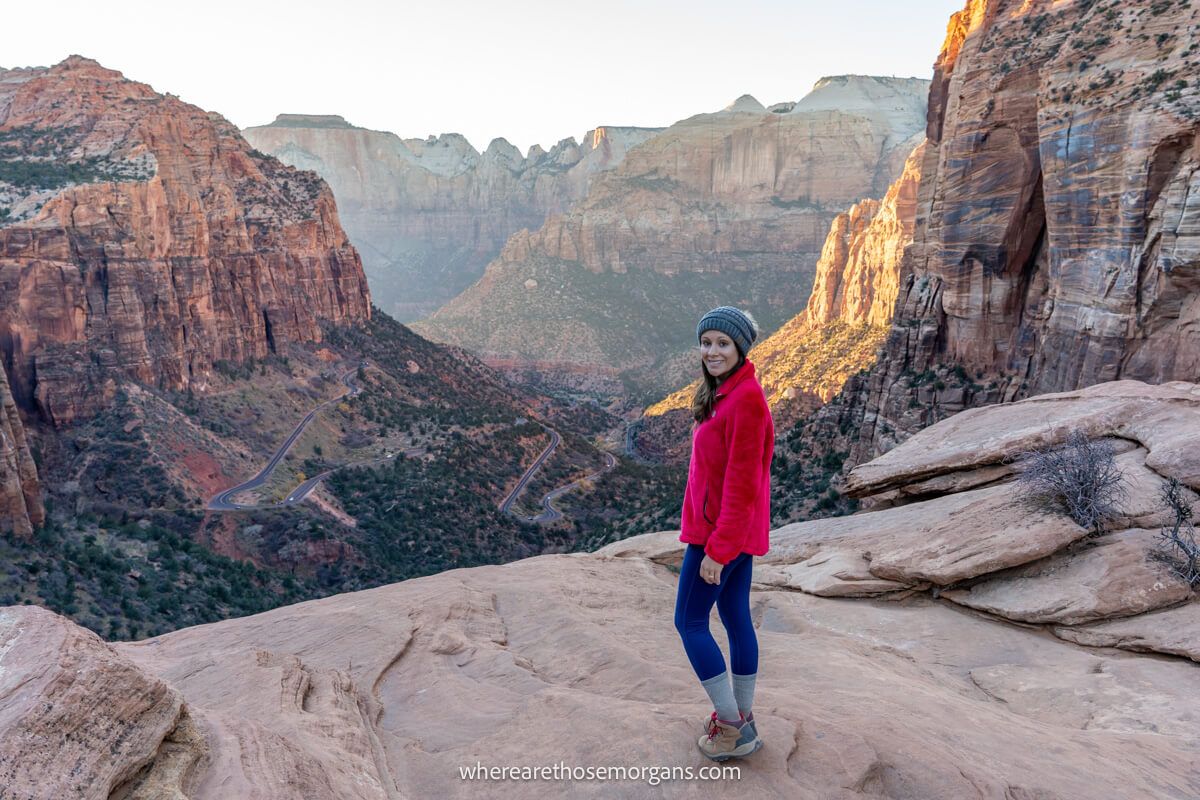
Zion is always in the top 5 most visited US national parks. In 2023 it was third with 4.62 million visitors, after the Smokies and Grand Canyon. But here’s the difference: Zion is a much smaller national park than you might imagine. Yes, it has more than one canyon, but almost everyone prioritizes the main canyon, which becomes densely crowded between April and October.
Consider this: Yellowstone is 2.2 million acres in size and all of Zion is just 149,000 acres. And the main Zion canyon where all the visitors go is only a part of that overall size. And Zion gets more visitors than Yellowstone.
Now, let’s take a look by month. According to the NPS, here are the monthly averages for Zion’s visitors between 2015-2019:
- January – 91,562
- February – 112,890
- March – 333,271
- April – 431,935
- May – 477,342
- June – 534,610
- July – 557,200
- August – 491,483
- September – 476,783
- October – 391,538
- November – 216,742
- December – 136,061
Note: We think pre-covid data better represents normal traveling conditions. But we recommend taking a quick look at this NPS report which is updated to show monthly visitors up to the current date. You’ll see patterns and trends are similar post-covid.
As you can see, most visitors arrive to Zion between April and September. But the numbers are still relatively high for March and November. Now take a look at those numbers for December, January and February. It’s a huge contrast. In fact, if you add the three winter months together, you only get 8% of all annual visitors. Compare that with the single month of July which accounts for 13% of all annual visitors.
What we can tell you from first hand experience is that even in October the crowds were significantly higher than in December. It was like night and day. So we can only imagine what it would be like in summer. The take home here is to appreciate the planet-sized perk of fewer crowds if you decide visit Zion in the winter.
How Will Fewer Visitors Benefit You?
- Hiking trails are quieter
- More hotel rooms available
- Cheaper hotels
- Easier to win hiking permits
- No need to reserve restaurants
- Easier to enjoy nature
- Get a bit of a lost world feel
READ: When’s the best time to visit Zion?
2. Weather
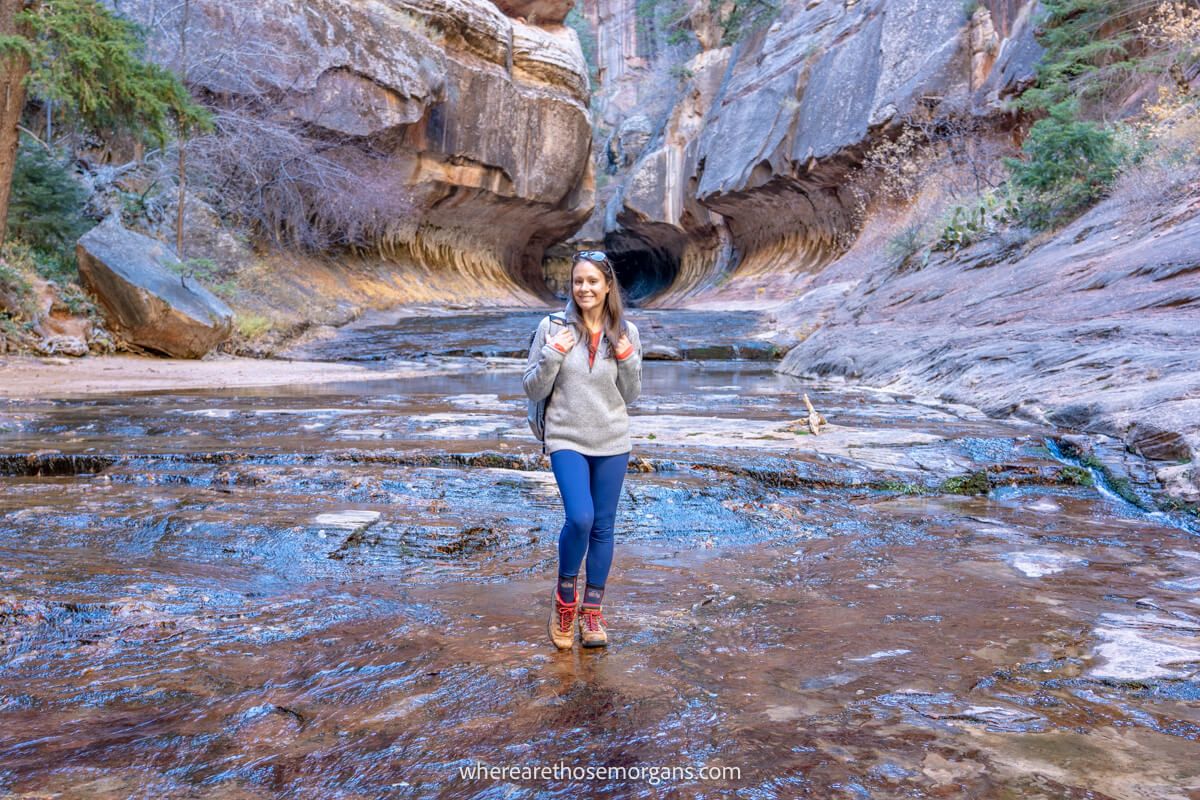
Zion’s winter weather is typically cold overnight but crisp and cool during the day. Here are the monthly average lows and highs:
December:
- Low – 30F
- High – 54F
January:
- Low – 30F
- High – 54F
February:
- Low – 34F
- High – 59F
Source: NPS Weather and Climate
Look, we won’t sugarcoat it, you will be cold if you visit in December or January. But it’s one of the only downsides to going in winter. We had exactly the weather conditions we expected in December: bitterly cold mornings and evenings sandwiched by comfortable hiking temperatures during the day. And as you can see, the average temperatures begin to rise in February so it’s not as harsh.
We hiked Angels Landing for sunrise and we’ll admit it was icy cold at the summit. But we knew it would be, so we carried plenty of layers including gloves and hats for the top. On the other hand, we were warm enough in light to middle layers when we hiked The Subway and Kolob Canyons during the middle of the day. So it’s not all bad, especially if you plan your activities between 10:00am-3:00pm.
Does It Snow In Zion During The Winter?
We know what you’re thinking: if you brave the cold weather, will you at least get to see Zion covered in snow? Well, the park does receive a very small amount of snowfall each winter but the snow rarely makes it down to the canyon floor. You might get lucky and see a light sprinkling of snow coat the red rocks, but it doesn’t happen often.
Need help planning your trip to Zion?
Our popular Zion travel guidebook helps you with planning every aspect of your visit, including the unmissable hikes, where to eat and stay, itinerary ideas and map!
View Zion Guidebook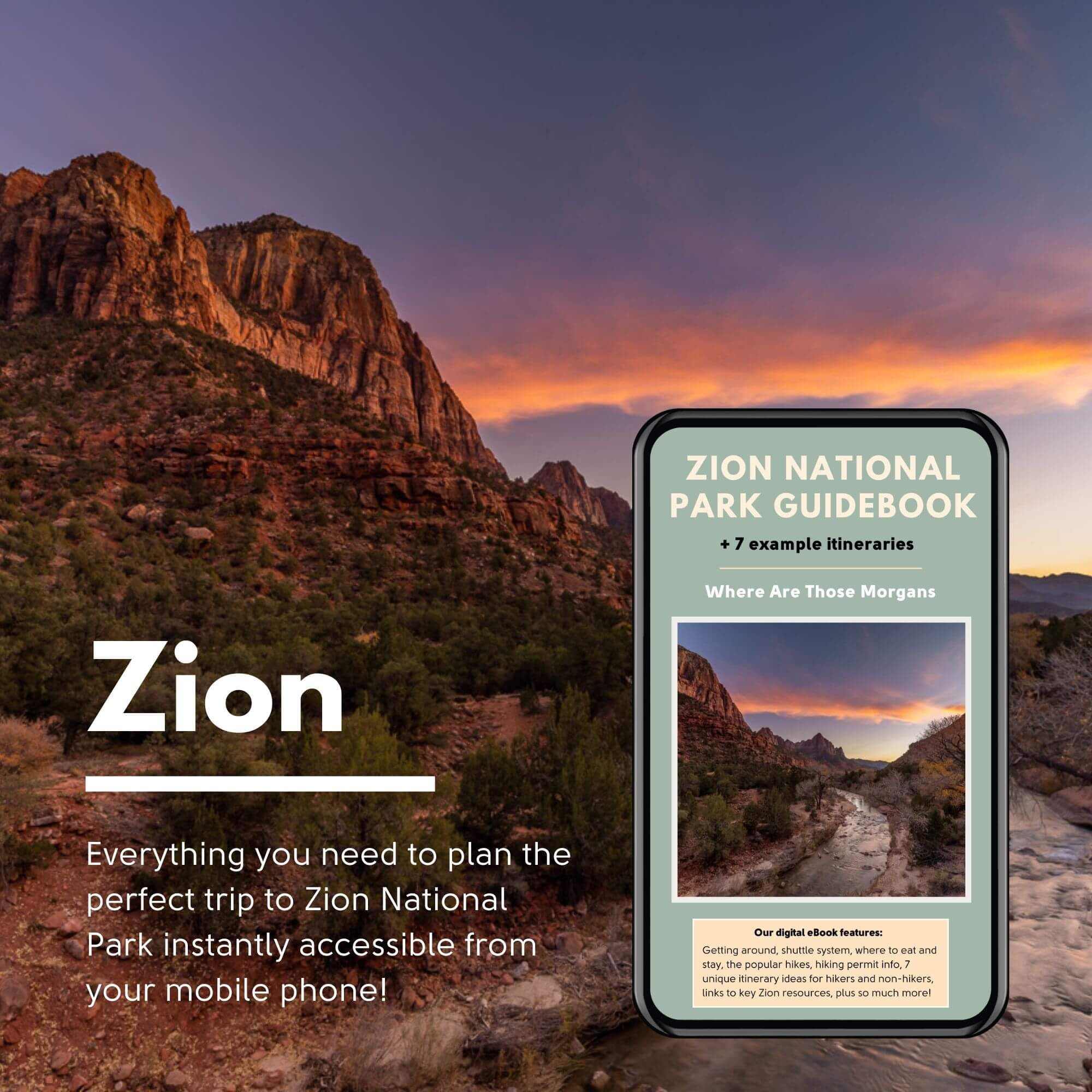
3. Roads
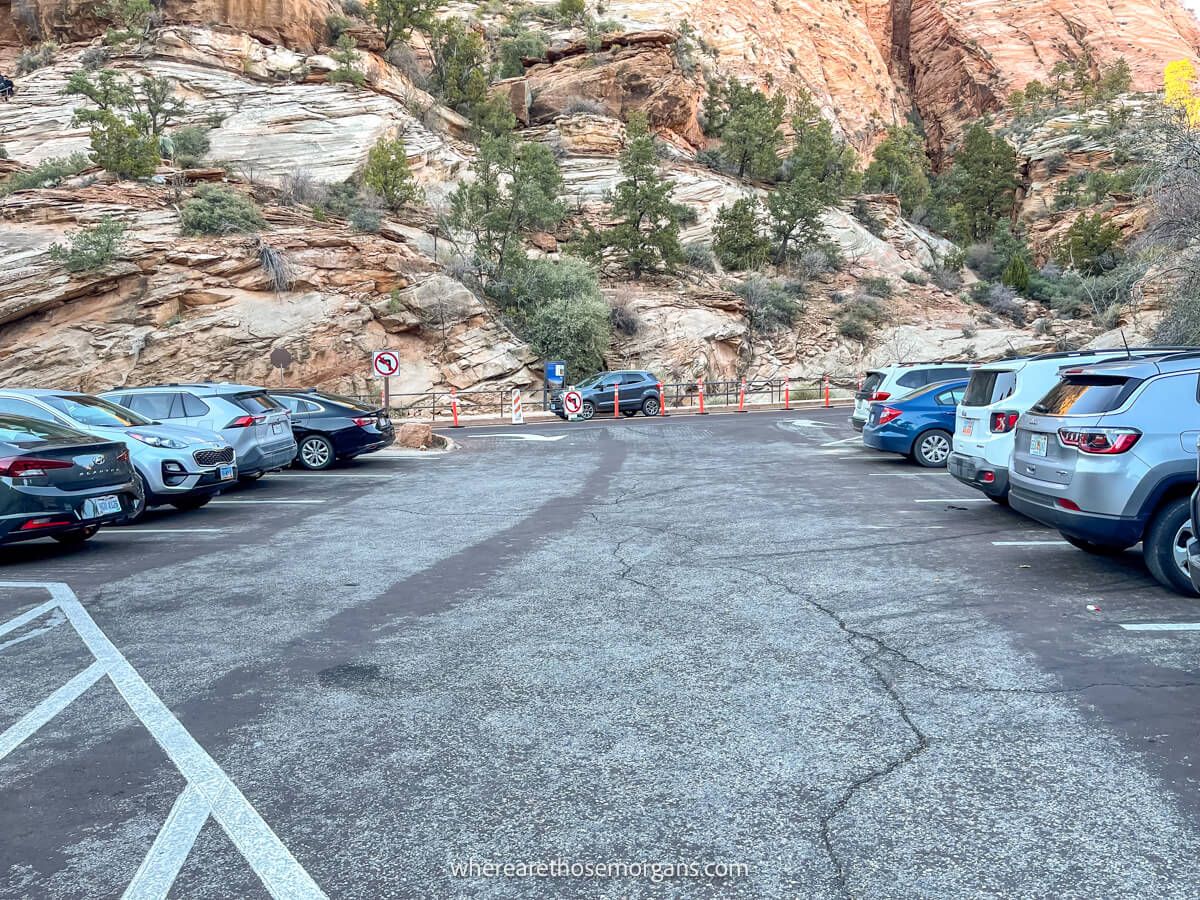
One of the major issues with planning trips to certain national parks in the winter is dealing with road closures. The good news is that all roads running through each region of Zion remain open year round. That includes Springdale and the most direct routes from the closest airports to the park.
With that said, it’s important to know that certain roads can be closed at very short notice due to excessive snow or ice. It’s rare, but it does happen. Therefore, we strongly recommend you check current road conditions for live updates on roads before and during your visit.
Now, let’s take a closer look at roads in each of the three major regions.
Main Zion Canyon
One of the biggest benefits to visiting Zion in winter is being able to drive your own vehicle into the main canyon. Between December-March (except the Christmas holidays) you are permitted to enter Zion Canyon Scenic Drive by car and park at all hiking trailheads.
That means you won’t have to figure out shuttle bus timetables, stand in long lines waiting for those shuttles or deal with finding parking spaces at the visitor center. In a nutshell, you’ll have so much more independence and flexibility.
One downside is that parking at the more popular trailheads like Angels Landing can be challenging, despite the significantly reduced tourist numbers. Just remember there are several places you can park along the scenic drive that have connecting trails to the more popular areas.
Kolob Terrace
Kolob Terrace is around 20 miles from the main Zion canyon and it’s where you’ll find Left Fork Trailhead which leads to The Subway. Read our guide to day hiking The Subway bottom up if you plan to apply for a permit.
The Subway is an amazing experience, but you do have to be aware of the roads suddenly closing in winter because it’s not as well maintained as the main canyon. This area is likely the first to close when the weather is poor.
Kolob Canyons
Kolob Canyons is the furthest region away from the main canyon at 40 miles, but it’s a hugely underrated part of the national park in our opinion. This lesser known area of the park is so quiet in winter that you’ll likely have a hike all to yourself. Read our guide on the 4 Kolob Canyons hikes for more information on the trails.
There’s only one way in and out of Kolob Canyons, but it has a small visitor center and the area is maintained. Keep an eye on current conditions in the days leading up to your visit and check daily weather reports.
4. Lodging
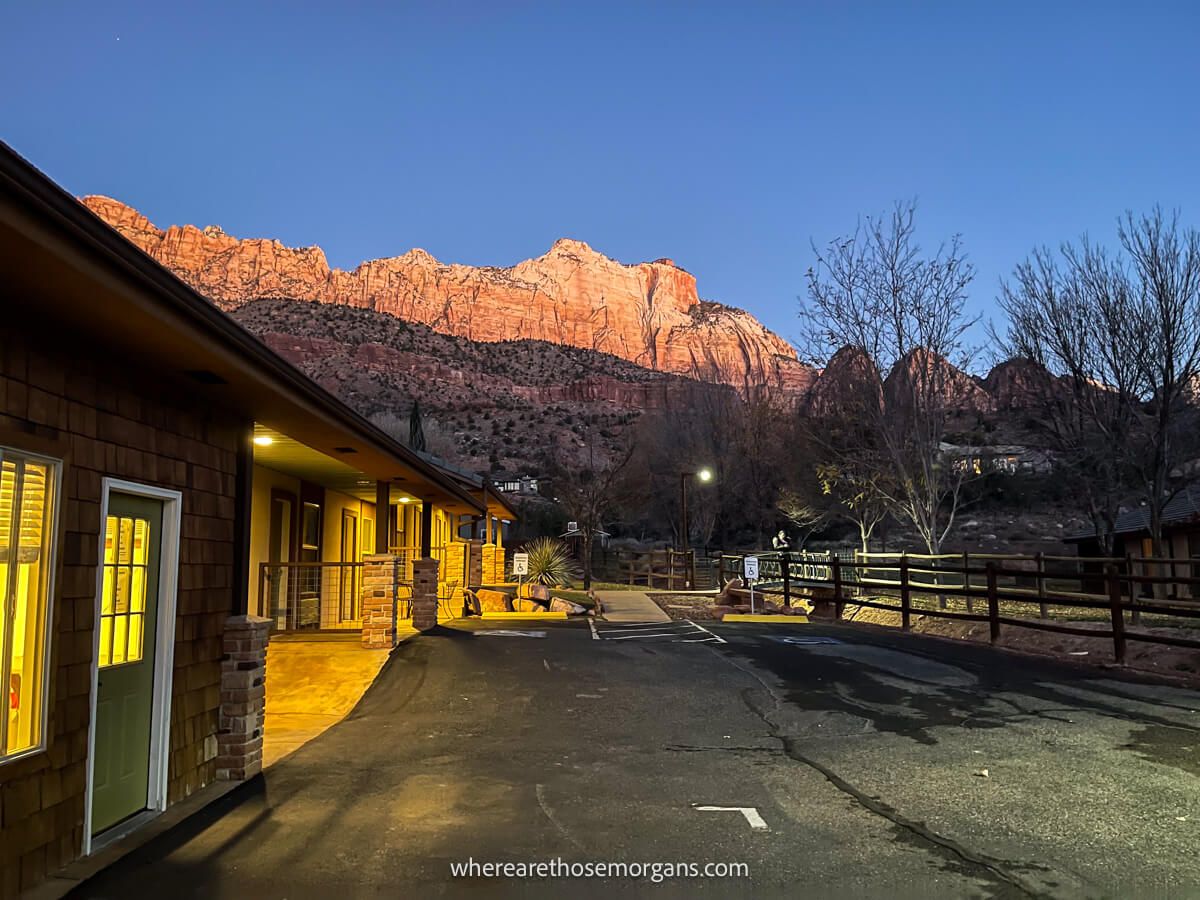
Zion is one of the better US national parks we’ve visited in terms of having plenty of convenient lodging options. The town of Springdale is one of our favorite resort towns serving a national park because it’s laid back, trendy, and has a ton of quality hotels and restaurants. But the downside is that hotels in Springdale come with a premium price tag in peak months.
Most visitors who want to save a buck or two will also take a look at hotels in La Verkin and Hurricane because they offer cheaper rates due to being less convenient for accessing Zion. But in peak months, even these further out hotels have significantly inflated nightly rates.
Enter, winter. When demand is low, prices are low. Our Springdale hotel in October cost twice as much as it did in December. But the major difference was that we could have stayed pretty much anywhere in Springdale for excellent value. In October, most hotels were booked up or whatever rooms remained had no value for money.
Zion Lodge
Zion Lodge is the only official accommodation option available inside the park’s boundaries. It’s located opposite the trailhead for Emerald Pools half way up the main canyon. You can book hotel rooms, suites or semi-detached log cabins. A buffet style breakfast is included but you have to pay extra for coffee (which we’re not impressed with).
We stayed at Zion Lodge for one night in December, so we could be as close as possible to Angels Landing for our sunrise hike (this was before permits were introduced). In truth, we were disappointed with the cabin we stayed in. It wasn’t clean and our connecting neighbors were loud. For the price we paid, we could have stayed in one of the most luxurious rooms in a top rated hotel in Springdale.
You can either book direct with the lodge or see if you can beat the price on Booking.com.
Where To Stay Near The Park
Springdale is the best place to book a hotel for your visit to Zion any time of year, but especially in winter when it’s more affordable. It has plenty of hotel options, restaurants, grocery stores, coffee shops and gear outfitters. If you’re visiting on a budget, take a look at La Verkin or Hurricane. The other popular place to stay is called Virgin, which offers unique glamping style accommodations at higher prices.
Springdale:
- Red Rock Inn Cottages
- Cable Mountain Lodge
- Marriott SpringHill Suites
- Best Western Plus
- Holiday Inn Express
- Hampton Inn & Suites
La Verkin:
Hurricane:
Tip: Read our popular guide on where to stay near Zion National Park which covers the best hotels for all budgets in Springdale and surrounding towns.
Camping
Do you have a motorhome or converted van? Or are you brave enough to tent camp at Zion in winter?! All campgrounds are closed in winter except Watchman campground, which is open but requires advanced reservations. There may be some walk in spots available but it’s always best to book ahead.
Watchman is the main campground in Zion and it’s located just a few minutes walk from the main visitor center. This campground is perfectly located for hiking The Watchman Trail and Pa’rus Trail, both of which are easier trails.
We spent a night in our tent at Watchman Campground when we visited the park in October. It was freezing cold at night then, so make sure you have heaps of warm gear if you camp in December, January or February.
Special: We’ve teamed up with The Dyrt to offer our readers an exclusive no strings 30 day free trial with The Dyrt PRO, which sends you notifications when sold out campgrounds like Watchman have cancellations.
5. Permits
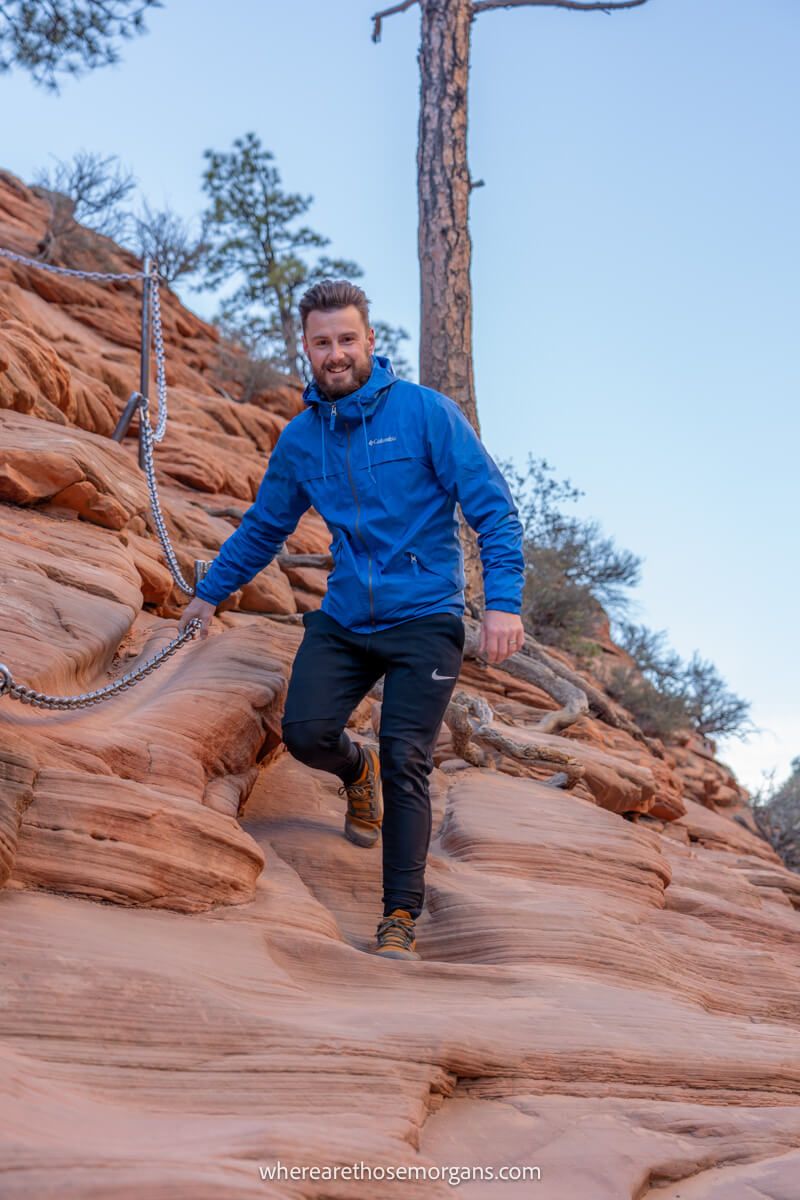
Hiking permits for popular trails in the US are notoriously tough to win through online or next day lotteries. Trust us, we know! We’ve had 3 attempts at Half Dome and haven’t been successful yet, so we know how frustrating it can be.
It doesn’t matter whether you visit Zion in spring, summer, fall or winter, you still need to win permits for the following trails:
Angels Landing: Permits are relatively easy to obtain but you have to select between 3 different time slots on any given day. Time slots are before 9:00am, 9:00am to 12:00pm and after 12:00pm. You might not get the slot you want in peak months, but you’ll be able to book whichever you want in winter. As a result you’ll have more itinerary flexibility. Permit information.
The Narrows: It’s important to know that you can hike The Narrows bottom up without a permit year round. It’s only if you want to hike the overnight top down version that you need a permit. When the water is cold in winter, there’s far less interest in the top down permit hike, so you have a great chance of getting it. Permit information.
The Subway: There are only 60 advanced reservation permits per day, as well as a minimum of 20 last minute draws or walk ins for a total of 80 daily permits for the bottom up hike. Top down there’s even fewer. In peak months, demand is high so you’re chance of winning is low. Whereas in winter, you have a great chance of picking up a walk in permit with ease. That’s exactly what we did in December. Permit information.
READ: 20 amazing places to visit in Utah
6. Angels Landing
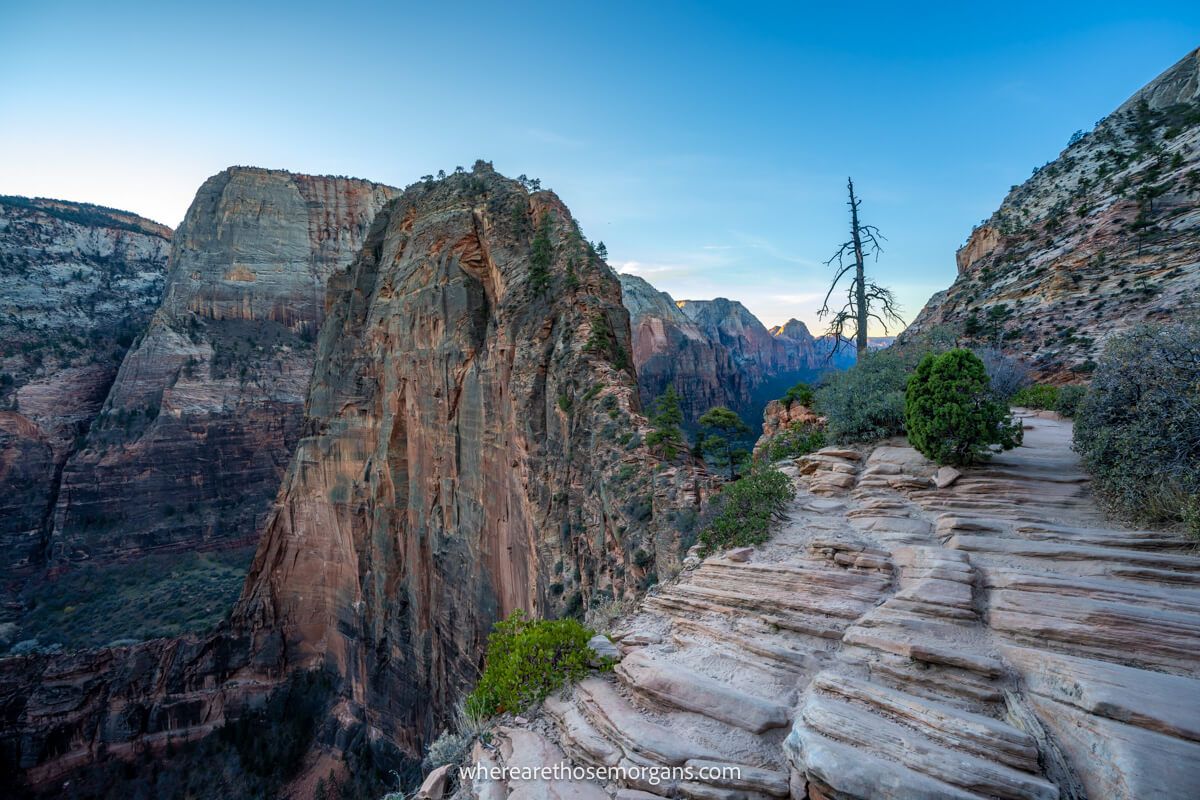
Angels Landing is the most iconic hike in Zion and we can tell you from experience that it’s safe to hike in the winter, just as long as the conditions are fine. Do not hike Angels Landing in below freezing temperatures after after rain or snow. It’s far too dangerous for that level of risk.
We first hiked Angels Landing in October and it was wild. There were so many people climbing up and down the razor-thin trail at the same time, we couldn’t believe how busy it was. It was before permits were required but even so, it was still a weekday in October.
That’s why we decided to hike for sunrise when we returned in December. It was freezing cold as we set off but we soon warmed up on the steep ascent up West Rim Trail. Luckily, there was no ice or slippery sections. And we arrived at the summit as the only two hikers, which was an amazing experience.
With permits in place and the fact it’s winter, you’ll be able to hike Angels Landing with far fewer hikers. We recommend applying for the pre-9:00am time slot so you can set off early when it’s even quieter.
READ: How to hike Angels Landing Trail
7. The Narrows
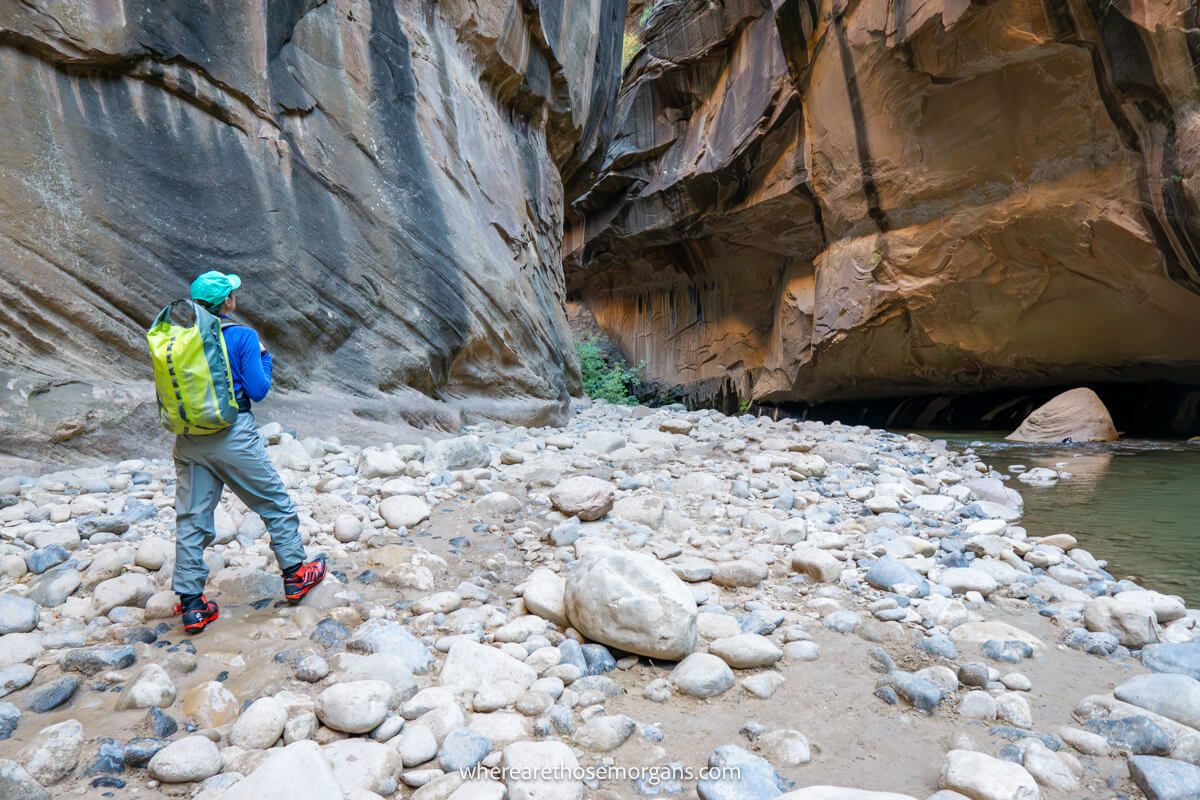
The Narrows is Zion’s most fun and unique hike. It’s also the busiest trail in the park, and it’s open year round. So it doesn’t matter if you visit in December, January or February, you can still brave the icy cold waters of the Virgin River. Remember, you can hike the bottom up version any time without a permit.
We hiked The Narrows in October. It was cold enough in the river then, but we made it all the way to the end of the permitted route on a bottom-up day hike called Big Springs (three waterfalls). We knew that we’d need to hire waterproof pants, socks and shoes if we wanted a shot at making it the whole way, so we rented the dry pants package at Zion Outfitter for around $50 each.
If you visit Zion in winter and want to hike a long way into The Narrows, you simply must have waterproofs. If you don’t have your own gear at home (not many do!), hire them at one of many outfitters in Springdale. But the single most important thing you need for the hike is a large and study wooden pole. Trust us, you won’t get far without one.
The further you get into The Narrows, the quieter it becomes. Even in October when it was busy, we had long stretches as the only people in the slot canyon. So if you go in winter you’ll likely have even longer stretches (hours maybe) where you won’t see another soul. Talk about a lost world feel!
READ: How to day hike The Narrows bottom up
8. Hiking
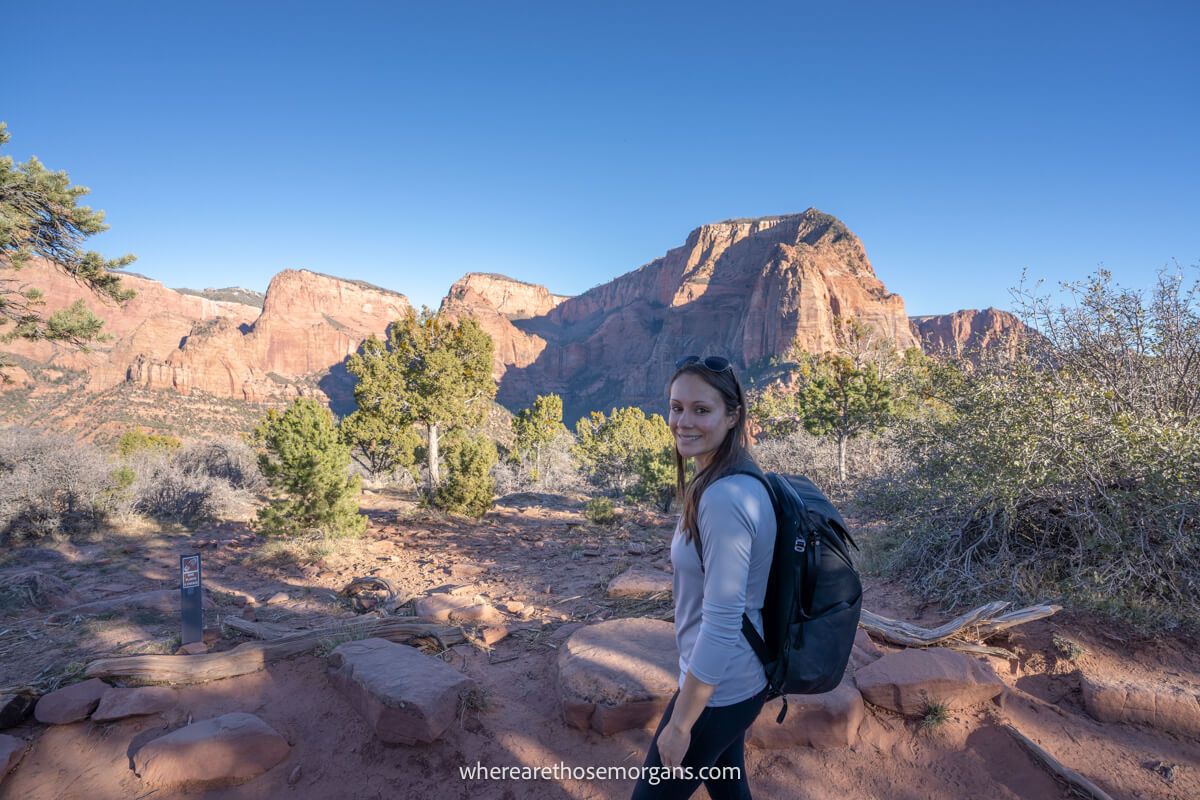
Okay, we know this is getting very hike-heavy. But that’s what Zion is all about. There’s not much else to do but hike to be honest. Now, we’ve covered Angels Landing and The Narrows in great detail because they’re so popular. But there are so many more fun hikes in Zion and we think December, January and February are perfect months for hitting the trails.
You’ll find the less adventurous and more family friendly hikes like Emerald Pools Trail or Zion Canyon Overlook to be relaxing, quiet and peaceful. They’re the complete opposite in peak months. Not only will there be fewer hikers on the trails, but you’ll also be able to park at trailheads more easily which is a huge deal in a place like Zion.
Canyon Overlook is a prime example. In October, cars were strewn all over the place near the trailhead. Traffic was backed up for miles either side of the Zion-Mt Carmel Tunnel and the summit was packed at sunset. When we hiked again in December, we easily parked at the trailhead and had the summit near enough to ourselves.
We also saw nobody else at the summit of Watchman Trail, Pa’rus Trail was deserted and we barely saw another person the whole time we were in Kolob Canyons. Although The Subway has a daily limit on permits, we saw maybe 5 other people all day. It was pure hiking bliss.
The only thing you need to remember is to wear and pack base layers, light middle layers and thick outer layers for when you stop at viewpoints.
READ: Unmissable hikes in Utah
9. Restaurants
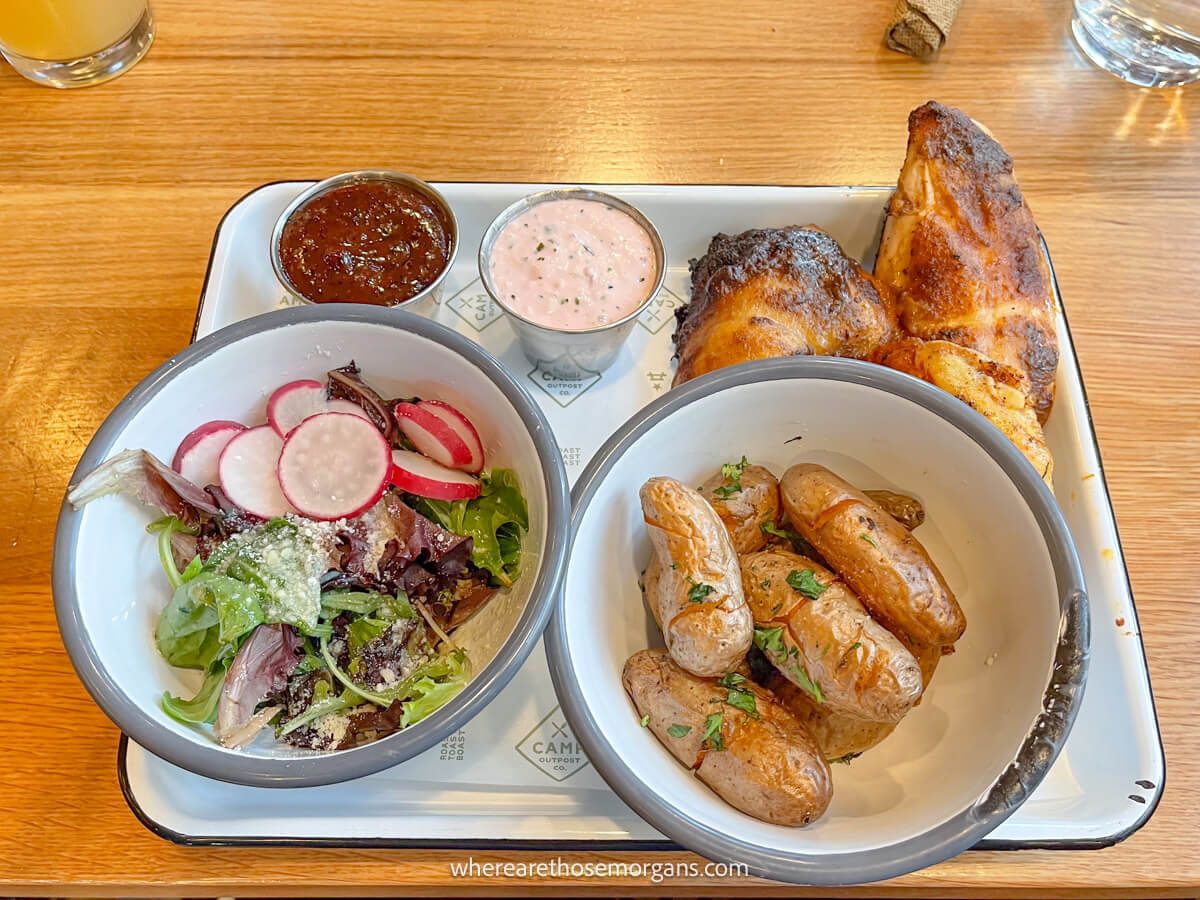
So far it’s been mostly positives (except the cold). Another minor downside to visiting Zion in winter is that a handful of restaurants in Springdale close for the off season. Not all of them close, but some will.
For example, we wanted to eat at Zion Pizza & Noodle Co, which is a popular pizza place and always has a line outside the door in peak season, but it closed for the season just as we arrived into Zion. But we were able to eat at Camp Outpost and Oscar’s Cafe, both were highly rated and they were excellent. Camp Outpost serves up rotisserie style American comfort food and Oscar’s is a Tex-Mex with a great atmosphere.
If you’re in the planning stages and you’ve already picked out a restaurant or two you like the look of in Springdale, be sure to check out their websites to see if there’s any information about seasonal closures. Load up Google Maps and see if the restaurant is open or closed by clicking on the restaurant name and checking opening hours.
The good news is that you won’t have to make reservations at the restaurants that are open in Springdale because it’s so much quieter. We struggled a few night in October when eateries were bouncing. It was great to see them doing so well, but not so great when you’re hungry after a day on the trails and can’t get in for hours.
10. Photography
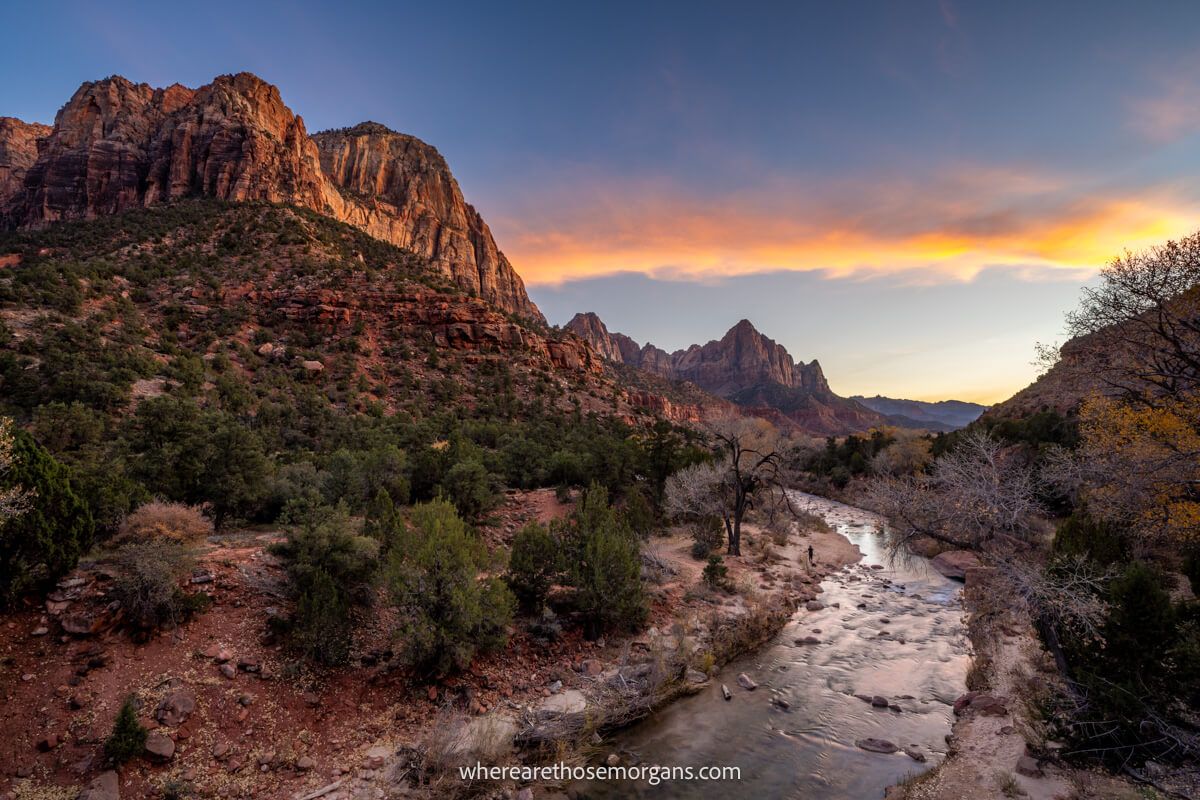
There’s no denying Zion is a photogenic national park. Just look at its dramatic canyons, red rock formations and wide open views. So although it’s primarily a hiking arena, Zion is also a fantastic place for beginner or pro photographers to flex their finger muscles.
Now, we actually think winter is one of the better times of year for photography in Zion because you’ll find fewer people at the top photo spots. There’s also a small possibility of snow. Plus, the days are shorter, which means later mornings for sunrise and earlier evenings for sunset.
When we were out photographing sunrises and sunsets we made sure we had plenty of heavy layers because it was brutally cold at dawn and dusk. But conditions for photographers are totally fine during the day.
We recommend Canyon Overlook at both sunrise and sunset, Angels Landing at sunrise, The Watchman for sunrise or sunset, and Canyon Junction Bridge at sunset. They’re our favorite photo spots in the park. Just remember you’ll need a tripod for low light photos.
The Morgan Conclusion
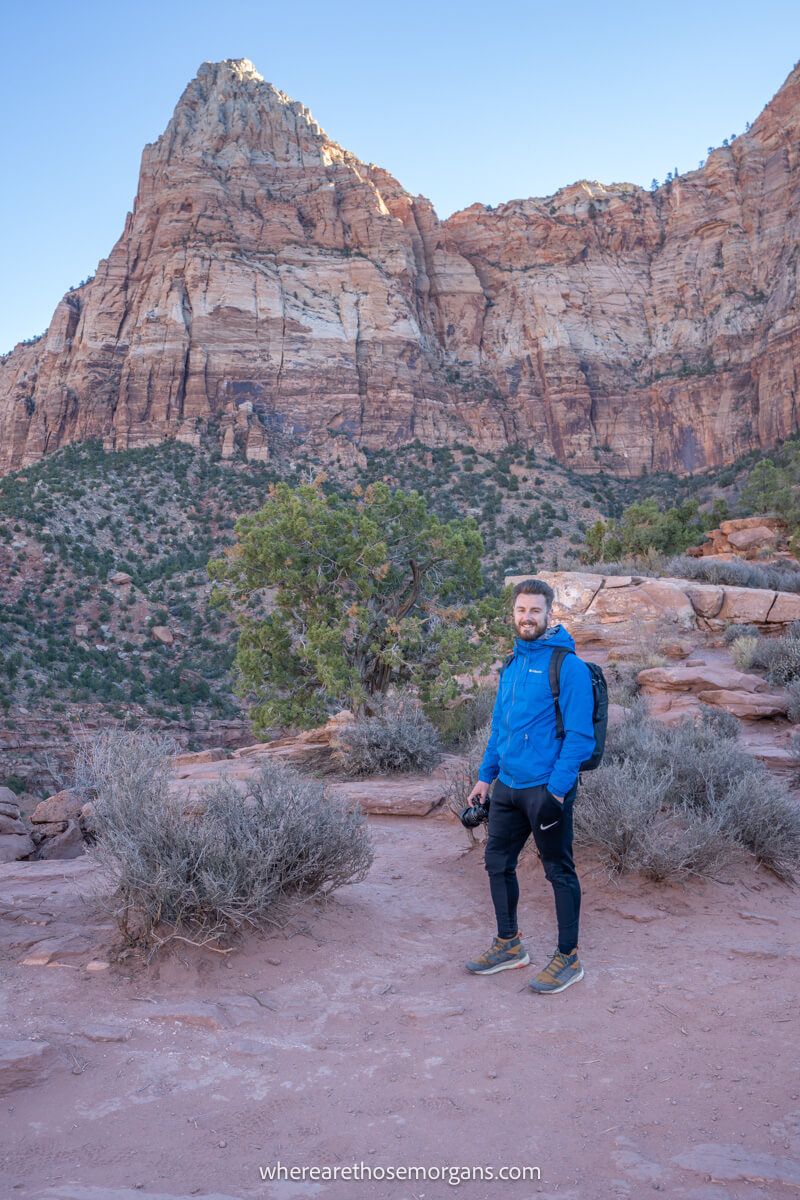
What we like: It’s hard to beat the sought after combination of fewer crowds and cheaper hotels when visiting a place like Zion. It’s too much of an understatement to say they’re good benefits. They’re more like game changers. Being able to use our own car was also amazing because we didn’t have to wait for shuttles or lose flexibility.
What we don’t like: The obvious one is cold temperatures. And we won’t lie, it did have an impact on our overall enjoyment because who likes being cold? But we accepted it, still hiked at sunrise and benefited from easily getting a walk in permit for The Subway.
Is it worth visiting Zion in winter? Yes! Zion is quiet, affordable and completely open in the winter. It’s easier to win hiking permits, the trails are crowd-free and restaurants in nearby Springdale won’t be too busy. If you don’t mind cold mornings and evenings, we think the winter months are among the best times of year to visit Zion.
More From Zion
- Hikes you can’t miss in Zion
- How to hike The Narrows
- How to hike Angels Landing
- Hiking Zion Canyon Overlook
- Where to stay around Zion
- One day Zion itinerary
- Which month to visit Zion
- Airports closest to Zion
Want more Utah content? Head over to our Utah Travel Guides to explore the mighty five national parks and beyond.
We hope our guide visiting Zion in the winter helps with planning your visit to Utah!
Please let us know if you have any questions in the comments below.
Happy Travels,
Mark and Kristen
Was this guide helpful? Pin it for your visit!
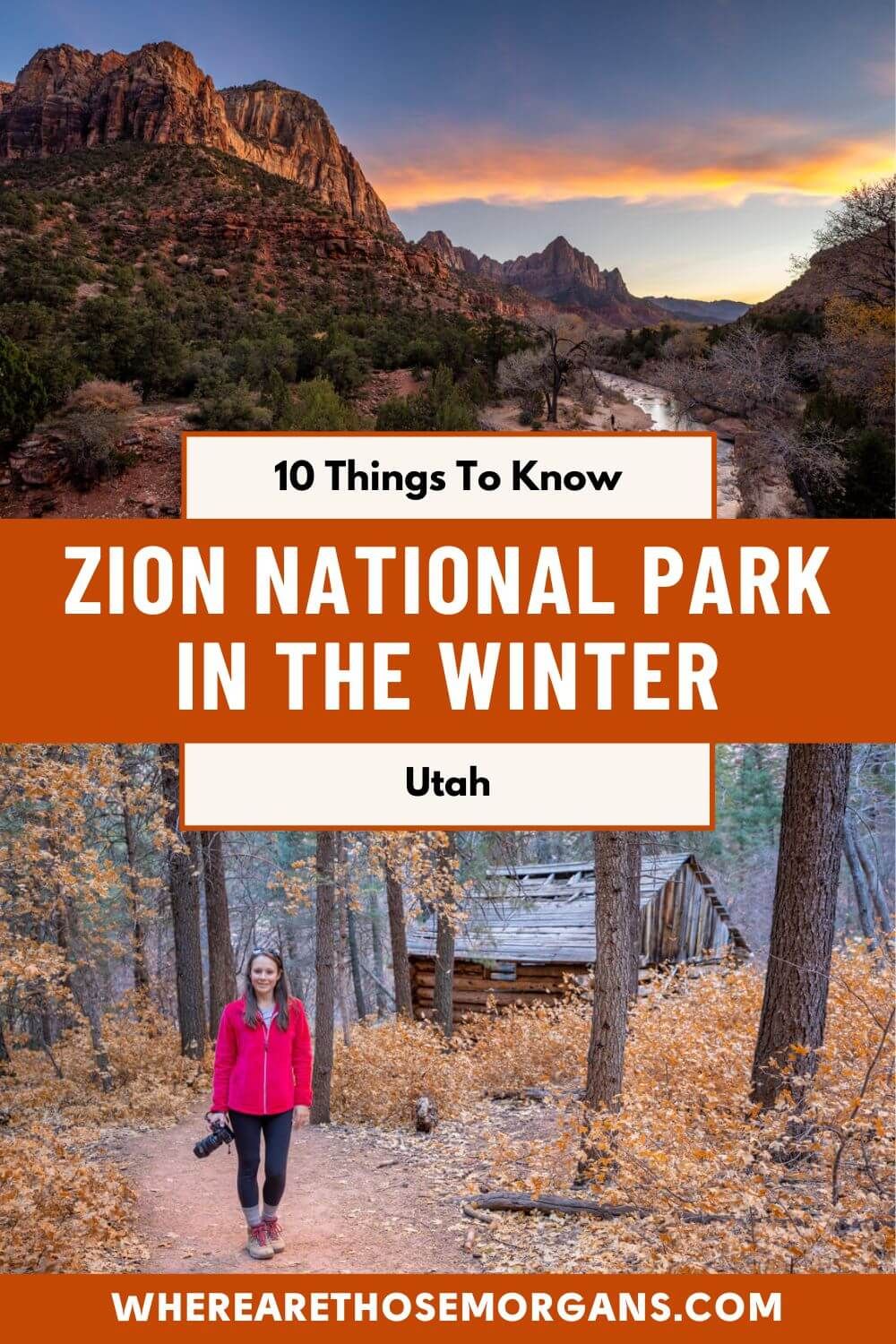
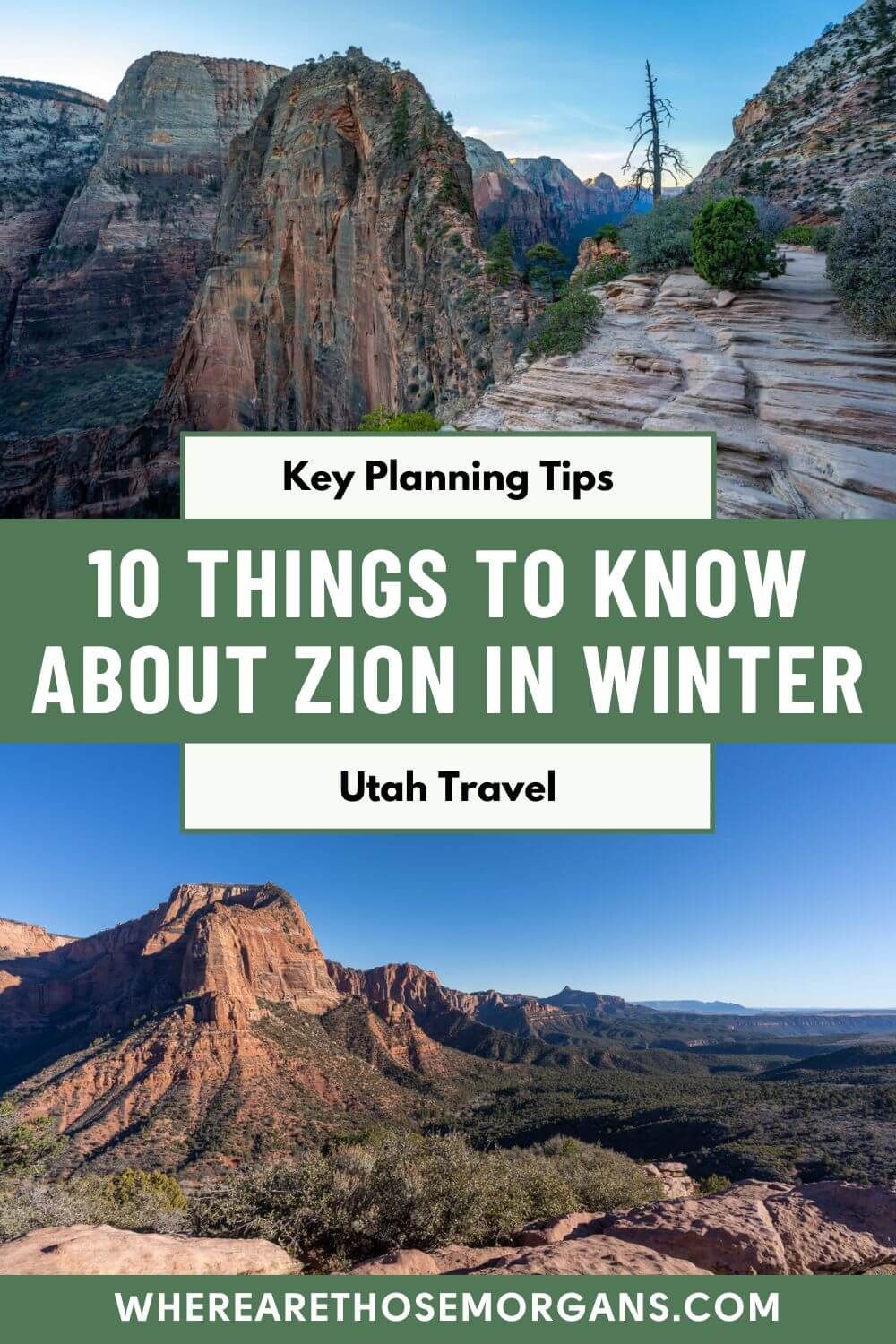
Note: This article contains affiliate links. When you make a purchase using one of these affiliate links, we may earn a small commission at no extra cost to you.
All Rights Reserved © Where Are Those Morgans, LLC. Republishing this article and/or any of its contents (text, photography, maps, graphics, etc.) in whole or in part is strictly prohibited.
Mark and Kristen Morgan are travel, hiking and photography experts. Over the last 6 years traveling full time, they have explored more than 40 countries and 30 US states.
Where Are Those Morgans has been featured in USA Today, Gestalten, Get Your Guide, CityPASS and Condé Nast Traveler along with various other publications. Read more about us.

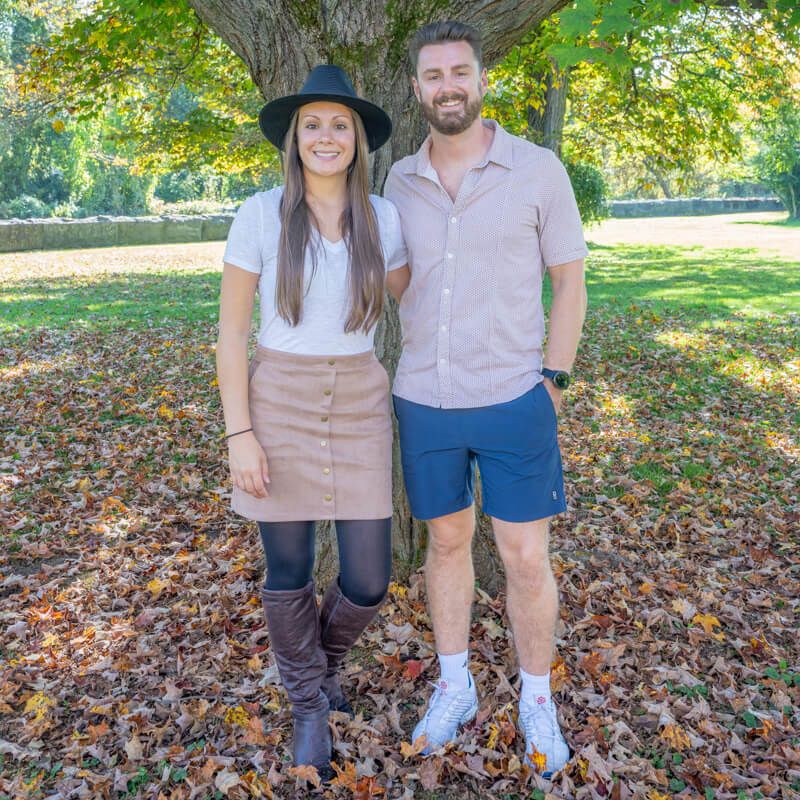

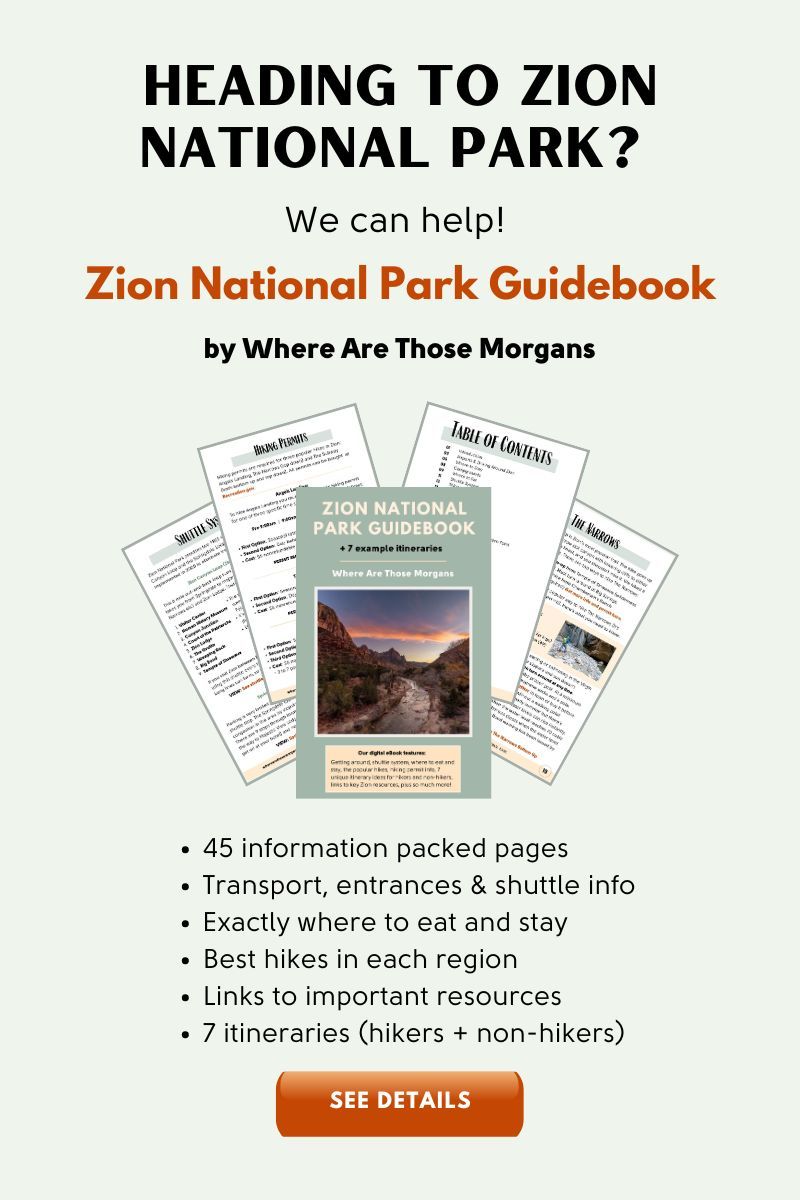
I am planning my first ever trip to Zion this December 2022 and this is the first blog that gave me complete information. except about the clothing (except for The Narrows). If you could have include a separate paragraph highlighting the winter clothing, that would have being the best. Afterall, all I am looking was that information. But overall very good content.
Hi Snehal, packing for Zion in December is challenging because you are going to need plenty of lightweight and heavy layers. The mornings are going to be freezing cold, so you’ll need a thick winter coat, thermal underlayers for both top and bottom, gloves and hat. If you plan to hike during the day you will need lightweight and medium-weight long layers on top and bottom, with spares because you will sweat a lot on ascents. Evenings are cold but not as chilly as the morning. Take at least one spare pair of everything including shoes just in case. Despite the cold temperatures, Zion’s canyon walls keep the worst of the wind away so wind chill shouldn’t be an issue. The best way to keep warm in the morning is to get out on the trails asap. Have a great trip!